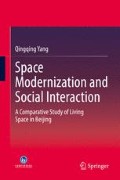Abstract
This study concerns space in the contemporary city of Beijing: how space is humanly built and transformed, classified and differentiated and most importantly how space is perceived and experienced. Specifically, the study focuses on inhabitants of traditional Chinese courtyards or ‘“Hutong’. The Chinese government is in the process of rehousing Hutong residents in new high-rise apartment developments; also the inhabitants are currently experiencing the changing living situation of having their living space developed for tourism.
Access this chapter
Tax calculation will be finalised at checkout
Purchases are for personal use only
Notes
- 1.
This means lane or bystreet, with traditional courtyards flanking on both sides. This is a traditional residential form built within the Old City or Inner City in Beijing, where most of the indigenous Beijingers dwell. Most of those houses in the courtyard in Hutong are very old and shabby, now with no modern facilities like bathrooms or toilets built in. Different from the modern compound, they don’t have security doors or CCTV to ensure the residents feel safe.
- 2.
For ethical reasons, I masked the name of the street.
- 3.
One of the gates on the inner city border
- 4.
In progress http://www.religion.ucsb.edu/?page_id=701
- 5.
National Bureau of Statistics of China http://www.stats.gov.cn/tjsj/ndsj/2005/indexch.htm
References
Bourdieu, P. (2003). The Berber house. In S. Low & D. Lawrence-Zuniga (Eds.), The anthropology of space and place. Oxford: Blackwell.
Deal, W. E., & Beal, T. K. (2004). Theory for religious studies. New York: Routledge.
Feld, S., & Basso, K. H. (Eds.). (1996). Senses of place. Santa Fe: School of American Research Press.
Feuchtwang, S. (Ed.). (2004). Making place: State projects, globalisation and local responses in China. London: UCL Press.
Freedman, M. (1979). The study of Chinese society. Stanford: Stanford University Press.
Gupta, A., & Ferguson, J. (Eds.). (1997). Culture, power, place: Explorations in critical anthropology. Durham: Duke University Press.
Herzfeld, M. (2006). Spatial of cleansing: Monumental vacuity and the idea of the west. Journal of Material Culture, 11, 127–150.
Ingold, T. (2011). Against space. In Being alive: Essays on movement, knowledge and description. London: Routledge.
Komlosy, A. (2002). Images of the Dai: The aesthetics of gender and identity in Xishuangbanna/Anouska Komlosy. University of St Andrews thesis (Ph.D.).
Lefebvre, H. (1991). The production of space. Oxford: Blackwell.
Park, R. E. (1952). In E. Hughes, C. Johnson, J. Masuoka, R. Redfield, & L. Wirth (Eds.), Human communities: The collected papers of Robert Park (Vol. 2). Glencoe: Free Press.
Skinner, W. (1951). Peasant organization in rural China. Annals of the American Academy of Political and Social Science, 277, 89–100.
Skinner, W. (1971). Chinese peasants and closed community—An open and shut case. Comparative Studies in Society and History, 13(3), 270–281.
Skinner, G. W. (2001). Marketing and social structure in rural China. Ann Arbor: Association for Asian Studies, c1964.
Soja, E. (1996). Thirdspace: Journeys to Los Angeles and other real-and-imagined places. Oxford: Blackwell.
Yang, M. (1994). Favors, and Banquets: The art of social relationships in China. Ithaca: Cornell University Press.
Yang, M. (2007). Ritual economy and rural capitalism with Chinese characteristics. In D. Held & H. Moore (Eds.), Cultural politics in a global age: Uncertainty, solidarity and innovation. Oxford: Oneworld Publications.
Yang, M. (2008). Chinese religiosities: Afflictions of modernity and state formation. Berkeley: University of California Press.
Author information
Authors and Affiliations
Rights and permissions
Copyright information
© 2015 Foreign Language Teaching and Research Publishing Co., Ltd and Springer-Verlag Berlin Heidelberg
About this chapter
Cite this chapter
Yang, Q. (2015). Preparing for the Fieldwork. In: Space Modernization and Social Interaction. Springer, Berlin, Heidelberg. https://doi.org/10.1007/978-3-662-44349-1_1
Download citation
DOI: https://doi.org/10.1007/978-3-662-44349-1_1
Published:
Publisher Name: Springer, Berlin, Heidelberg
Print ISBN: 978-3-662-44348-4
Online ISBN: 978-3-662-44349-1
eBook Packages: Humanities, Social Sciences and LawSocial Sciences (R0)

